MARKETING
3 Simple TikTok Tips to Grow Your Business
Louie Escobar
Louie Escobar joined the real estate industry in 2021 and immediately became the one stop luxury stop, coining himself “Louie from TikTok.” He curates his content for his ideal avatar, high end luxury home buyers in Dallas Texas, and has been going viral ever since hopping on the platform.
MARKETING
Roundel Media Studio: What to Expect From Target’s New Self-Service Platform

Roundel™ Media Studio (RMS) has arrived, revolutionizing Target’s advertising game. This self-service platform offers seamless activation, management, and analysis of Target Product Ads, with more solutions on the horizon.
Powered by first-party data from both in-store and online shoppers, RMS provides new audience insights. Coupled with Target’s new loyalty program, Circle 360, advertisers gain precision targeting like never before.
But Target isn’t stopping there. With the rollout of a paid membership program on April 7th, bundling Target Circle, the Circle Card, and Shipt delivery, Target is elevating its media and membership offerings to rival the likes of Walmart and Amazon.
Curious to learn more? We sat down with our experts at Tinuiti to dive deeper into the potential implications of this platform for brands and advertisers alike.
What is Roundel Media Studio?
Roundel™ Media Studio is an integrated platform that consolidates various solutions and tools offered by Roundel™. At its core, it kicks off with our sponsored product ads, known as Target Product Ads by Roundel™.
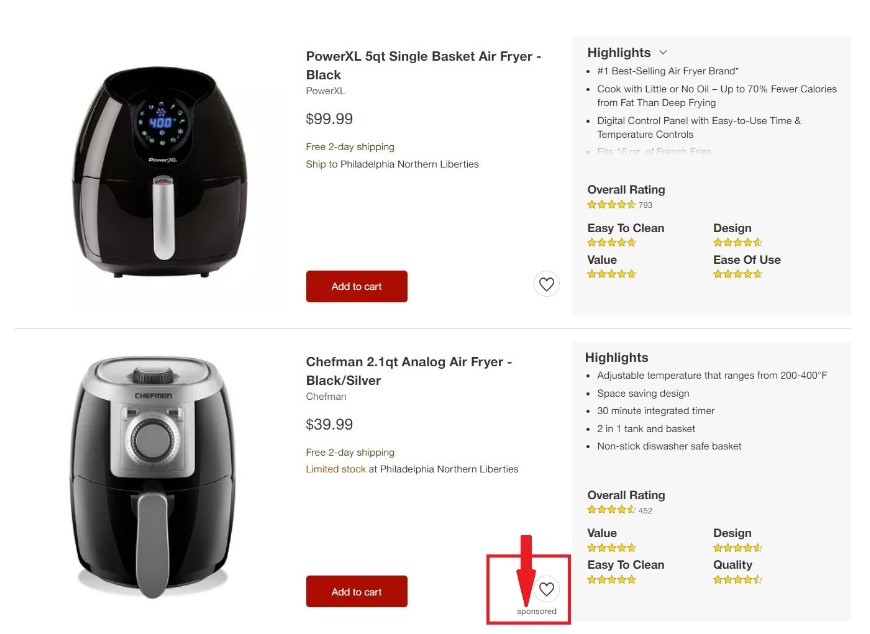
Image Source: Target.com
This comprehensive platform grants access to the complete range of Target Product Ad placements, featuring tailored slots like “More to Consider” and “Frequently Bought Together” to enhance relevance and personalization.
Moreover, Roundel™ Media Studio operates without any DSP or access fees for Target Product Ads, ensuring that your media budget is optimized to deliver greater efficiency, more clicks, and ultimately, increased sales.
“One of the larger benefits of the transition is that advertisers have an opportunity to capitalize on the additional dollars saved by switching to RMS. Without the 20% fee, brands can re-invest those funds to scale campaigns or optimize budgets, all without having to allocate more funds which drives better results. Roundel™ is putting more control in the hands of advertisers by introducing this new self-service platform.”
– Averie Lynch, Specialist, Strategic Services at Tinuiti
To summarize, key benefits of using RMS include:
- No Access or DSP Fees
- All Target Product Ads Inventory
- 1st Price Auction with Existing Floor Prices
- Closed Loop Sales & Attribution
- Billing via Criteo Insertion Order
- Access Using Partners Online
How to access Roundel Media Studio
According to Target, there’s 3 steps to access Roundel™ Media Studio:
Step 1. Check that you have a Partners Online (POL) account for access. Don’t have one? Reach out to your POL admin to get set up with an account (reach out if you need help locating your organization’s admin).
Step 2. Once you have gotten access to POL, reach out to your Roundel representative who will grant you access to the platform.
Step 3. Users can access Roundel™ Media Studio in 2 ways:
Roundel Media Studio Best Practices
Target offers a variety of tips on how to best leverage their latest offering to drive performance.
Let’s take a look at the latest best practices for strategies such as maximizing efficiency or driving sales revenue.
Recommended bidding tactics for maximizing efficiency:
- Set your line-item optimizer to Revenue for the highest return on ad spend (ROAS) or to Conversions for the lowest Cost per Order (CPO).
- Since the Revenue and Conversions optimizers modulate the CPC you enter to maximize performance, it is useful to set a CPC cap to make sure that your bid will not exceed the maximum amount you wish to pay. The CPC cap should always remain at least 30% above the bid you enter to allow the engine to optimize effectively.
- Set your bids competitively to balance scale and performance (ROAS or CPO) targets.
- Optimize bids with respect to your CPO targets: lower CPCs slightly to increase efficiency, or raise them to increase scale
Recommended bidding tactics for maximizing sales revenue:
- Set the line-item optimizer to Revenue.
- Set bids to maximize scale and competitiveness while staying above KPI thresholds. Since the Revenue optimizer modulates the CPC you enter to maximize performance, it is useful to set a CPC cap to make sure that your bid will not exceed the maximum amount you wish to pay.
- Adjust your bids progressively and preferably at the product level: filter the top products by Spend and then slightly reduce any bids that have a ROAS below your threshold.
- In general, slightly lower CPC to increase efficiency or raise CPC to increase win rates and therefore increase sell-through.
Takeaways & Next Steps
This is just the start for RMS. In the future, Tinuiti will continue its partnership with Roundel to refine features and introduce additional ad types and functionalities.
When exploring any new advertising opportunity, the best results are typically realized when partnering with a performance marketing agency that understands the unique landscape. Our team boasts years of hands-on experience advertising in new and established marketplaces, including Amazon, Walmart, and Target. Working directly with Roundel, we ensure our clients’ ads harness the full functionality and features Target has to offer, with results-oriented scalability baked in.
Ready to learn more about how we can help your brand? Reach out to us today!
MARKETING
Unlocking the Power of AI Transcription for Enhanced Content Marketing Strategies

Have you noticed how artificial intelligence (AI) is slowly integrating into, well, everything? Then it won’t surprise you to hear that it’s also infiltrated content marketing.
How can AI enhance your content marketing? Through AI transcription.
Want to learn how?
Why AI Transcription is Revolutionary
AI transcription is transforming the way we access and interact with information. Here’s how it’s changing the game:
Rapid Content Transformation
Imagine turning a one-hour podcast or webinar into a comprehensive text document in minutes.
AI transcription allows for quick conversion of long-form audio and video content, making it a breeze to repurpose these materials into articles, blogs, or reports.
This means you’re spending a lot less time working on making your content as accessible as possible—the AI is doing it for you—and more time on simply creating new content.
Inclusivity and Accessibility
By providing a text version of audio and video content, AI transcription breaks down barriers for people with hearing impairments. This widens your audience.
It also aids non-native speakers in understanding the content better by allowing them to read along, improving comprehension and engagement.
Content Amplification
With AI transcription, a single piece of content can be repurposed into a multitude of formats.
For example, a transcribed interview can be used to create an in-depth blog post, several engaging social media posts, and even quotes for infographics. This not only amplifies your content’s reach but also maximizes the return on investment for every piece of content created.
SEO Benefits
Transcripts can be a goldmine for SEO. They are rich in keywords spoken naturally during conversations. Including these transcripts on your website or blog can significantly improve your search engine ranking by providing more content for search engines to index.
Real-Time Engagement
With real-time transcription services, audiences can follow along with live events, like conferences or webinars, through captions. This enhances the interactive experience and viewers don’t miss out on important information.
AI transcription is revolutionary because it democratizes content, making it accessible and usable in a variety of formats. It caters to a global audience, and multiplies the impact of the original content, all while improving SEO and user engagement.
Integrating AI Successfully
To truly tap into the power of AI transcription, you need a game plan. It starts with picking the right AI transcription service—one that’s not only accurate but also savvy with the lingo of your field.
Here’s how you can integrate AI transcription into your workflow like a pro:
Record Quality Content
The clearer your audio or video recording, the better your transcription will be. Invest in good recording equipment, minimize background noise, and ensure speakers articulate clearly. Think of it as laying the groundwork for flawless transcription.
Transcribe with AI
Once you have your high-quality recording, it’s time to let the AI work its magic. Upload your file to AI technology like Clipto and let it transform your spoken words into written text. This step is where the tech shines, turning hours of audio into text in minutes.
Edit and Polish
AI is smart, but it’s not perfect. Review the transcript for any errors or awkward phrasings. Adjust any text you need to. This editing process ensures the final product is not only accurate but also engaging and readable.
Incorporate into Your Strategy
Now that you have your polished transcript, use it to upgrade your marketing materials. Transcripts can be repurposed into blog posts, social media content, eBooks, or even used to enhance video and podcast SEO by providing searchable text.
AI transcription is a dynamic tool that can extend your capabilities. By treating AI as a collaborative partner, you can enhance your content marketing efforts, making your message clearer, more accessible, and far-reaching. Integrating AI transcription allows you to engage with your audience on multiple levels.
Spicing Up Your Content with AI Transcription
Let’s get real—AI transcription is more than just a fancy way of turning chatter into text. It’s a secret weapon in your content marketing arsenal.
Boosting Quality and Nailing Relevance
Think about it: when you transcribe your audio and video goodies, you’re capturing every little detail and nuance that might have slipped by unnoticed. Here’s the scoop:
- Accuracy is Key: With AI, you can nail the exactness of your content, catching the subtle hints and expressions that give it flavor.
- SEO Magic: Those transcripts are like SEO gold, stuffed with keywords that naturally pop up in conversation, giving your site’s visibility a hearty push.
And the cherry on top? AI transcription can sort out the big themes in your content, keeping your marketing vibe consistent and spot-on across all platforms.
Digging into Data
Now, here comes the detective work. AI transcription lays out all the juicy data about what your audience loves (and doesn’t). With this goldmine of info, you can:
- Analyze Engagement: Spot the hotspots in your videos or podcasts where people hang on every word—and where they hit the fast-forward button. This insight is like a roadmap to your audience’s heart.
- Strategize with Confidence: Armed with data, you can tweak your topics, amp up engagement, and keep your audience coming back for more.
So, by turning your spoken content into text, you’re not just filling up space. You’re diving deep into the analytics pool for a smarter, more data-driven approach to content marketing. It’s about getting down to the nitty-gritty of what your audience really likes, making every word you publish count.
Bottom Line
It’s clear that AI transcription is not just a fleeting trend but a robust ally in the realm of content marketing. Equipped with tools to make your message not only heard but felt across the globe.
From crafting precision-packed text that search engines adore to unveiling layers of audience insights waiting to be explored, AI transcription is your go-to for making every piece of content count.
MARKETING
How To Adapt Your SEO and Content Strategies for SGE and AI Experiences
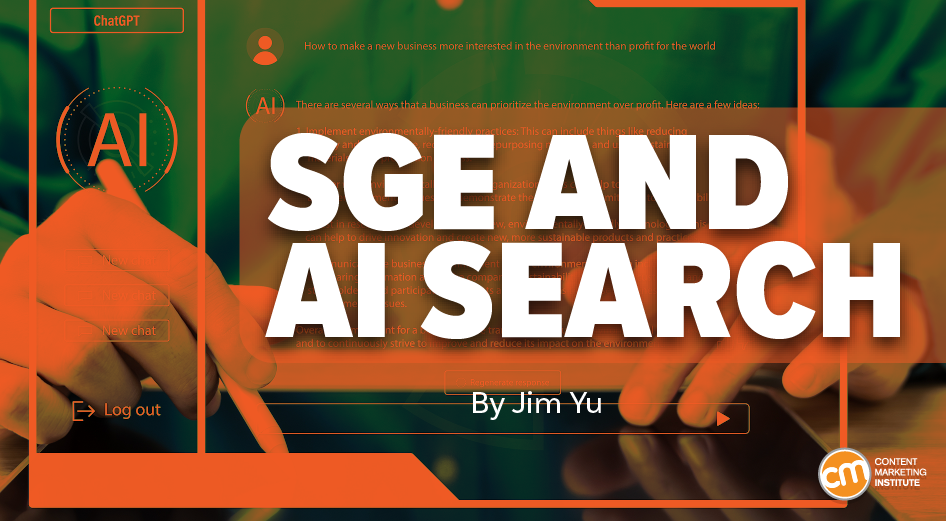
A massive change is coming to search.
As Google experiments with AI in its standard search results and its Search Generative Experience (SGE), marketers must understand how to adapt their content strategies for new AI-impacted search experiences.
Since 2023, Google has been prolific in its AI experimentation, changing the way content is represented in search results. Its content-led SGE recently moved out of its testing lab to show up in a small percentage of results in Google’s main search interface.
Brands that produce content experiences that align with new search behaviors and focus on conversion stand a better chance to survive the search change.
Google adds generative AI, first-person reviews, and anti-spam actions
Your news feed says all. Search and generative AI investments are everywhere. And it’s not just Google — new entrants, such as Perplexity AI and You.com, are on the search scene. Meanwhile, OpenAI is working on a search engine powered by Microsoft’s Bing.
Still, Google owns the biggest market share in search, so let’s focus on the ways AI is affecting Google SEO.
Reddit and new content sources
Google added new content sources to its traditional results and Search Generative Experience.
In traditional search results, adding more content sources helps fine-tune its AI technologies. The recent content licensing deal with Reddit is a prime example. You can already see its content appearing more often in traditional search results.
This screenshot shows the search engine results for “Is Volvo a good car?” A discussion from the Volvo subreddit appears as the third result on the page (or fourth if you count the people-also-ask module.)
Click to enlarge
SGE appearance
The image below shows the SGE for the Volvo query. The first paragraphs are an AI-generated summary drawing on ratings from RepairPal (after an alert explaining the experimental nature of the generative AI content.)
Below the SGE summary, a search box prompts the visitor to ask a follow-up question. After that element, the Reddit discussion on Volvo reliability appears.
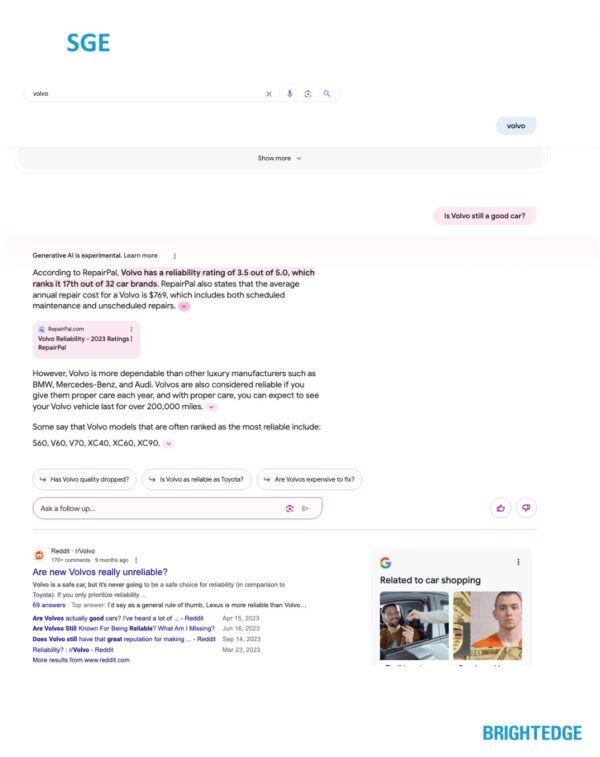
Click to enlarge
Showing Reddit content in SERPs lets Google show more first-person reviews and opinions (the experience element of Google’s EEAT (experience, expertise, authoritativeness, and trustworthiness) for search ratings.
But how will Google distinguish between subjective, objective, and informative opinions? With Reddit content, which can include positive and negative opinions readily on display, brands will need to follow relevant discussions on Reddit.
Google goes after spam sites
You may have read about Google’s latest update, which aims to avoid sites with low-quality (often AI-generated) content and give helpful content more prominence in SERPs.
This hammers home the message to avoid relying on generative AI alone for content creation. Content needs a human touch to earn the experience, expertise, authoritativeness, and trustworthiness that Google and, more importantly, searchers want to see.
Expect more penalties from Google for content that’s just churned out from AI prompts.
SGE’s impact on brands
SGE is the rollout that will impact every industry and content marketer.
My company, BrightEdge, built a tool to detect how and where search engines experiment with AI and new content formats. The chart below shows an estimate of the percentage of queries by industry affected by SGE results once it’s fully rolled out.
Health care will see the biggest impact, with 76% of its searches affected by SGE. Finance will be the least affected, with only 17% of queries impacted by SGE. Here’s how SGE will affect other industries:
- E-commerce (49%)
- B2B technology (48%)
- Insurance (45%)
- Education (44%)
- Restaurants (36%)
- Entertainment (36%)
- Travel (30%)

Click to enlarge
Once SGE rolls out completely, it will likely impact over $40 billion per year in ad revenue on Google for marketers per BrightEdge estimates.
How to prepare for SGE and changing search behavior
Google has always shown relevant sources and articles so searchers can make informed decisions. With the generative AI changes, Google’s engine now asserts an opinion. This represents a fundamental shift in how a search engine responds to queries.
Imagine you search the web to learn more about a BMW model you’re interested in. Previously, a Google search would display results with links such as BMW’s official site, Top Gear, Consumer Reports, and Carfax. The searcher then could choose the resources to explore and form an opinion about the vehicle.
In the generative AI world, Google’s primary result might not be a direct link to BMW’s website. Instead, it could be AI-generated content that provides an evaluative perspective. The AI content might include important factors to consider when looking at a BMW, such as the potential for high maintenance expenses or issues with parts availability due to supply chain challenges. This AI-curated summary will be presented before the searcher can see the resources with links for further exploration.
This shift may lead to reduced but higher-quality traffic. Brands are likely to experience better conversion rates. The reason? Consumers are more likely to act because they’ve been influenced by prior engagements and information provided by Google.
Still, you’ll need to adapt to the new search environment. Here are some tips on how to prepare.
Focus on the search basics
Solidify your foundation of SEO and website fundamentals. The essential elements will gain more significance as time progresses.
Make sure your website is optimized for user-friendliness and complies with Google’s guidelines regarding Core Web Vitals, Helpful Content, and EEAT (experience, expertise, authoritativeness, trustworthiness).
You may also want to review these tips for optimizing content for SGE.
Deepen your understanding of new search behaviors
Use data to grasp user and conversational intent, especially since these factors influence the AI-generated search results. Identifying high-value searches is essential.
Make sure that your content responds to the specific query and addresses its broader context to attract results for long-tail keyword searches.
Content generated by AI draws from reliable and credible sources. Ensure your brand’s content is considered an authoritative source.
The growing prominence of trusted sources and an increase in consumer reviews signal a pivotal change: Brands are likely to have less control over the customer journey.
Align content with other marketing disciplines
Search engine results now encompass an array of media types and formats, including social media, reviews, and news sources. So, teams in marketing, content creation, digital strategies, brand management, design, social media, and public relations must align closely.
Strategies for an AI-first future
According to BrightEdge research, 98% of enterprise organizations say they’ll prioritize SEO in 2024. And 94% of organizations are looking to integrate SEO into all marketing (omnichannel) strategies.
Strategies for adapting your content approach to new search experiences will vary by industry. Here are a few examples.
E-commerce: Google commonly presents content for e-commerce queries via product viewers. SGE replaces these with better, more visual, and informational (combined) content.
Google has experimented with several formats, including a general shopping result that details what a searcher would expect to see in a universal listing. However, as SGE results have evolved, so have the ways a user can view products.
This image shows an example of SGE’s integrated product viewer carousel with grouping for apparel, which displays multiple apparel options in a single display.
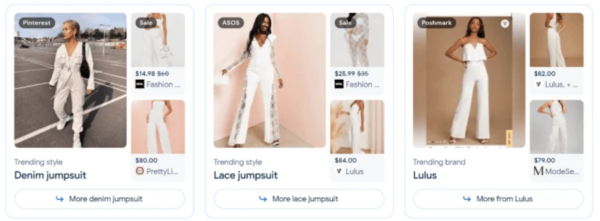
These tips will help you prepare for the various viewer modules (see viewer examples).
- Optimize for trend relevance: Aligning category pages with current trends can increase your chance of being included in SGE dynamic displays.
- Incorporate product reviews: Showing product reviews on your site boosts credibility.
- Present clear pricing Information: Use schema markup to highlight pricing details.
Travel, restaurants, and local: Places have long been a key module for Google. Now, we’re seeing the places module showing up in about 45% of SGE queries. So, make sure to include location-based keywords.
You might also try these optimization suggestions:
- Monitor and respond to reviews.
- Tailor your local listings for location-specific queries.
- Keep an eye on how and where SGE displays local modules. SGE displays local results even in queries without location-specific terms.
Entertainment: SGE entertainment results are primarily informational. But more reviews (and warnings for age-appropriate content) are appearing in both traditional search and SGE.
Get ready to shift your SEO thinking
Whoever provides the best experience for their target consumers will win in the new AI search experiences. Focus on third-party content reviews, social, PR, and brand authority. Expect your competitive landscape to change with new entrants that might eat into your market share.
Be aware, ready, and prepared to optimize for multiple AI search experiences.
All tools mentioned in this article were suggested by the author. If you’d like to suggest a tool, share the article on social media with a comment.
HANDPICKED RELATED CONTENT:
Cover image by Joseph Kalinowski/Content Marketing Institute
-

 PPC5 days ago
PPC5 days agoHow 6 SEO Experts Are Navigating Google Update Chaos
-

 SEO7 days ago
SEO7 days agoMeta Plans A Less Punitive AI-Generated Content Policy
-
SEARCHENGINES7 days ago
Daily Search Forum Recap: April 5, 2024
-

 MARKETING6 days ago
MARKETING6 days ago12 Facebook Ad Metrics Worth Your Attention
-

 WORDPRESS3 days ago
WORDPRESS3 days ago10 WordPress Influencers to Follow in 2024 – WordPress.com News
-

 MARKETING4 days ago
MARKETING4 days ago60 Remote Work Stats to Know in 2024
-

 SEARCHENGINES5 days ago
SEARCHENGINES5 days agoBing Search Testing Removing Cache Link From Search Results
-

 SEO6 days ago
SEO6 days agoThe Essential Guide To Using Images Legally Online











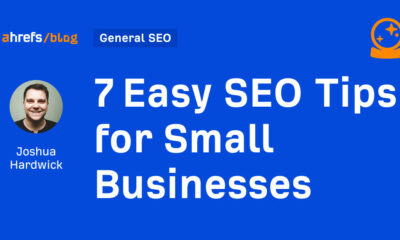



You must be logged in to post a comment Login